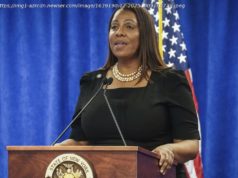U. S. businesses ramped up hiring in October, and wages rose by the largest year-over-year amount in nearly a decade, a combination that is pulling a rising share of Americans into the job market.
Note: This article has been corrected.
WASHINGTON — U. S. businesses ramped up hiring in October, and wages rose by the largest year-over-year amount in nearly a decade, a combination that is pulling a rising share of Americans into the job market.
In the final major economic report before Tuesday’s congressional elections, the government said Friday that U. S. employers added a robust 250,000 jobs in October. The unemployment rate stayed at a five-decade low of 3.7 percent.
Healthy economic growth is spurring employers to hire at a rapid pace that shows no sign of flagging even with the economy in its 10th year of expansion. With the supply of unemployed dwindling, companies appear to be finally putting up generous enough pay raises to attract and retain employees.
Average hourly wages rose 3.1 percent in October from a year earlier, the fastest annual gain since 2009.
Still, inflation has picked up a bit in the past year as well, eating away at some of those pay raises. And the increase in wages last month also partly reflected a one-time drop in pay a year ago because of Hurricane Harvey.
Even so, October’s increase suggests that after a decade of anemic growth, wage growth is picking up. At the same time, an influx of new job-seekers increased the proportion of Americans with jobs to its highest level since 2009.
The economy has now added jobs for 97 straight months, a record. That steady hiring has helped reduce the unemployment rate for Latinos to 4.4 percent, a record low. Teenage unemployment dropped last month to 11.9 percent, the lowest since 1969. And the proportion of Americans without a high school degree who are working has reached the highest point on records dating from 1992.
« It doesn’t get any better than this, » said Sun Wong Sohn, chief economist at SS Economics. « Evidently, the word has spread that there are good jobs to be had at decent wages. »
Cheyenne Mauzy of Springfield, Missouri, had held out for higher pay when she started job hunting in June. She felt she needed a high enough hourly wage to make up for the cost of child care for her three children.
« There was a minimum we had to make, » Mauzy, 28, said, referring to calculations she made with her husband. « I had to bring home enough on top of child care. If I am just going to work to pay for our child care, I should be our child care. »
In late August, she took a job at a hospital in Springfield that pays $11.22 an hour.
Becky Frankiewicz, president of staffing firm ManpowerGroup North America, said companies are trying a variety of strategies to fill jobs. Many retailers are removing the label « seasonal » from their job postings and looking for permanent workers instead. Others are dropping their requirements for a college degree.
« We absolutely see employers getting more and more creative about ways to get people in, » Frankiewicz said.
By some measures, consumers are the most confident they have been in 18 years, and their spending is propelling brisk economic growth. The economic expansion is now the second-longest on record, and October marked the 97th straight month of hiring, a record streak.
Strength in their customer demand has been a key factor leading companies to steadily add workers. Though economists have predicted that hiring will eventually slow as the pool of unemployed Americans dwindles, there’s no sign of that happening yet.
Still, the latest month of healthy job growth might not tip many votes in the midterm elections. Polls have suggested that while Americans generally approve of the economy’s performance, that sentiment hasn’t necessarily broadened support for President Donald Trump or for Republican congressional candidates.
The strong job growth and bigger pay increases will likely encourage the Federal Reserve to keep raising short-term interest rates. Most analysts expect the Fed to resume its rate hikes in December.
Hurricane Michael, which slammed into the Florida Panhandle and southern Georgia last month, had no discernible effect on the jobs data, the government said. Still, October’s outsize gain might have reflected, in part, a rebound from September, when Hurricane Florence depressed job growth.
Hiring in October was strong in higher- and middle-income jobs. Professional and business services, which include engineers, architects and accountants, gained 35,000 jobs. Manufacturers added 32,000 after two months of smaller gains, defying fears that Trump’s trade fights would slow hiring in that sector. Construction companies added 30,000 positions.
Retailers barely hired, adding just 2,400 positions, possibly reflecting the Sears bankruptcy. Restaurants and hotels gained 33,000, most of them lower-paying.
In the July-September quarter, consumer spending grew by the most in four years and helped the economy expand at a 3.5 percent annual rate. That growth followed a 4.2 percent annual pace in the April-June quarter. Combined, the two quarters produced the strongest six-month stretch of growth in four years.
Housing remains a weak spot in the economy, with sales of existing homes having fallen for six straight months as mortgage rates have risen to nearly 5 percent. But slower sales have started to limit home price increases, which had been running at more than twice the pace of wage gains.
Although pay increases can help boost spending and propel the economy’s growth, they can also lead companies to raise prices to cover their higher labor costs. That trend, in turn, can accelerate inflation.
So far, though, inflation remains in check. The Federal Reserve’s preferred price measure rose 2 percent in September compared with a year earlier, slightly lower than the year-over-year increase in August.
Correction: This story has been corrected to show that teenage unemployment fell to the lowest since 1969 last month, not the lowest on record.






